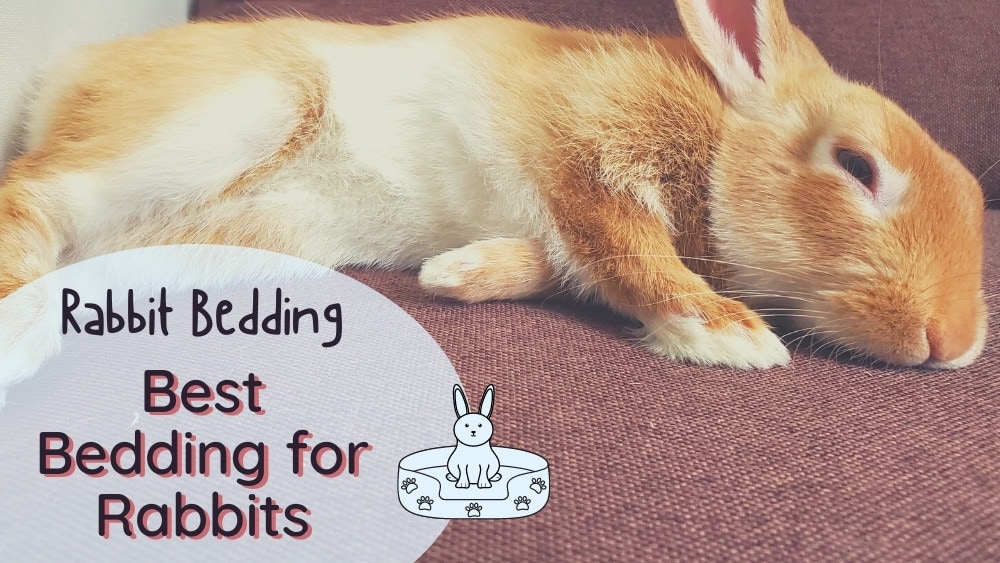The ways people keep pet rabbits – and, as a result, the materials we choose for bunny bedding – have radically changed over the past forty years.
In the “old days” of rabbit keeping – that is, in the centuries after the Medieval “walled rabbit gardens” but before rabbits were commonly kept as house pets – most rabbits lived year-round in the family farmyard. They were housed in wooden hutches filled with straw bedding.
Today, however, most pet bunnies lounge in luxury within the family home. So do indoor pet rabbits still need that straw bedding?
Actually, there are other materials available now that are both safer than straw and more effective at odor control. Our favorite is called Carefresh Small Animal Bedding, made of fluffy, chemical-free, absorbent, biodegradable shredded paper.

How do you use bedding in a rabbit cage? Do indoor rabbits need a bed to sleep in? What about outdoor bunnies – what is the best bedding for them?
We’ll answer these questions and others in this complete guide to rabbit bedding.
Bedding Vs. Litter
Before we jump into the pros and cons of rabbit bedding options, let’s clarify our terms.
Bedding. In this article, we’re going to use the term “bedding” to refer to nesting material that’s incorporated into a rabbit’s habitat for warmth or comfort.
Litter. We’ll use the term “litter” when talking about absorbent material that you place in a rabbit’s litter box to soak up moisture and reduce odors.
All rabbits need litter in their enclosure to help them recognize their potty spot and to reduce mess and smell. However, rabbit bedding – material intended for a rabbit to curl up and snooze in – is often unnecessary for indoor pet rabbits for reasons we’ll discuss below.
What Bedding is Best for Rabbits?
The safest bedding materials for rabbits include shredded paper or paper-based products like CareFresh, hardwood aspen shavings, or clean and sanitized straw. Straw is the best insulator, but paper is the most absorbent. You should never use clay-based cat litter, dusty bedding like sawdust, or softwood pine or cedar shavings as rabbit bedding.
Where Do Rabbits Like to Sleep? Do Rabbits Need a Bed?
Rabbits have very different sleeping habits from humans or larger pets like dogs. Since they are prey animals, they tend to be light sleepers. They’re most active at dawn and dusk. They’ll catnap around the clock – sometimes while sitting up – but bunnies go into a deeper sleep for a few hours each night and during the middle of the day.
But even when rabbits are deep in slumber, they prefer to lie down on a hard surface (like the floor) rather than a squishy bed. That way, should danger threaten, they can jump up and run at a moment’s notice.

Rabbits don’t need pillows or covers for warmth (they wear their own blankets all the time!) and will more likely shred a cozy pet bed than sleep in it. So don’t bother purchasing these items for your pet rabbit.
Instead, consider one of these options for your rabbit’s bed:
- Castle or Hiding Hole. In the wild, rabbits sleep underground or beneath a shrub or bramble pile so they can stay out of predators’ sight. While your bunny would be perfectly safe sleeping in the middle of the floor in your home, it may prefer to have a box, igloo, or wooden “castle” to sleep in, mimicking its natural habitat.
- Nesting Box. Similar to a castle, nesting boxes give rabbits the sense of sleeping in a burrow. However, unlike rabbit castles, nesting boxes have a solid floor. The floor provides extra warmth and protection from predators for outdoor rabbits.
- Ceramic Tiles. It may not sound comfy to us, but rabbits like to lie down on smooth cool tile. You can purchase 12” x 12” stone or ceramic tiles at a hardware store and chill them in the refrigerator on hot days before placing them in your rabbit’s enclosure.
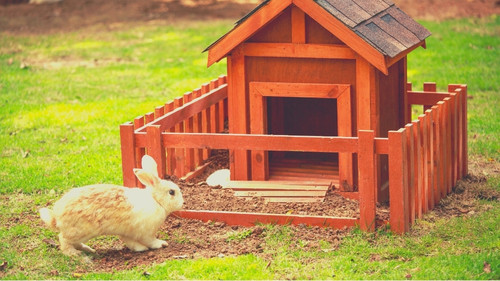
But Do Rabbits Need Bedding?
If you provide your rabbit with a castle or nesting box, should you fill it with absorbent or cozy bedding? The answer depends on your rabbit’s environment.
For indoor rabbits, bedding is unnecessary. In fact, there are good reasons to skip using it altogether:
Reasons To Avoid Bedding for Indoor Rabbits
- Mess. No matter what kind of bedding you use – paper pellets, shavings, or straw – it will make a mess that spreads around your home. You’ll find it stuck to your socks daily – and I know this from experience!
- It confuses rabbits. If you fill a box with wood shavings, rabbits may mistake it for their litter box. This may make litter training more difficult.
- Odor and Health Risk. If your rabbit does start using its bed as a bathroom, the smell will build up quickly. According to Dr. Esther van Praag at MediRabbit, ammonia is not only irritating but toxic to the delicate respiratory system of a rabbit. Damp and dirty litter also invites mold, fly strike, or other health concerns.
- Biosecurity Risk. Natural bedding, such as pine shavings, is notorious for carrying pathogens, mites, or fleas into your home. Even though most shavings are kiln-dried, which should kill pathogens or insects, I’ve personally seen foreign materials and even bugs in bags of rabbit bedding.
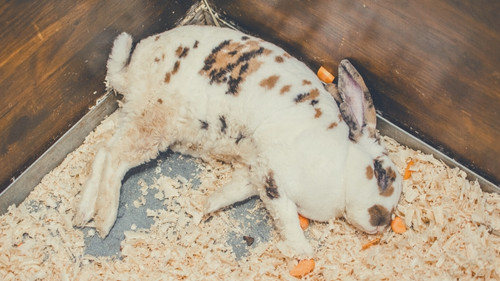
What To Look For in Safe Rabbit Bedding
So what makes rabbit bedding safe? If you choose to use bedding for your rabbit, make sure it ticks the following boxes.
- Edible. Call it a virtue or a vice, but rabbits chew everything in sight. So rabbit bedding must be safe to ingest.
- Dust-free. Dusty bedding (such as sawdust, ground hay product, or clay litter) can irritate rabbits’ lungs and make them susceptible to respiratory infection. Old hay or straw that’s been stored outdoors is often moldy as well as dusty, which is even worse.
- Fragrance-free. Rabbits have an acute sense of smell, estimated to be 20x better than a human’s. Never use bedding or litter treated with a masking fragrance, even a “natural” one like lavender oil. Remember, “natural” does not equal safe! Instead of using scented bedding, clean or replace the bedding daily to keep it smelling fresh.
- Sanitized. Recycled paper-based beddings such as Carefresh or Fresh News are much less likely to carry pathogens or insects than natural ones like straw or shavings.
- Different from the Litter You Use. If you place bedding in a rabbit’s nesting box for comfort, it should be a different material from the litter you use in its potty box. This will help your rabbit differentiate between the two.

Best Bedding for Indoor Rabbits
If you choose to use bedding in your indoor rabbit’s nesting box, here are the products we like the best:
1 – CareFresh 99% Dust Free Small Animal Bedding

Our top choice is CareFresh bedding, made from biodegradable sustainably-harvested paper pulp.
This bedding is packed tightly into a cube that expands many times its size; you’ll be amazed at how long one package lasts. Free from dyes or chemicals, this bedding is fluffy-soft and very absorbent.
It’s not the best for outdoor rabbits, however, because it doesn’t provide much insulation.
2 – VitaKraft Fresh World Bedding
While this is also a paper product, there are two primary differences between VitaKraft and CareFresh.
For one, VitaKraft is a rolled paper pellet, while CareFresh is a fluffier flake product. Secondly, CareFresh is manufactured directly from new paper pulp, while VitaKraft uses recycled paper. They are comparable in function.
3 – Woven Grass Mat

While not “bedding” in the traditional sense, a grass mat fits the bill for indoor bunnies. They will find grass comforting and secure to rest on.
Honestly, rabbits will dig in and play with any kind of bedding, and a grass mat – while still susceptible to rabbits’ incisors – will make less mess than shredded paper.
What Should you Put in the Bottom of a Rabbit Cage?
As mentioned earlier, rabbits don’t need a bed. Your bunny might not choose a regular place to sleep, but instead flop on your floor anywhere he feels comfortable.
However, if you keep your indoor rabbit in a pet pen or a cage, the floor of your rabbit’s enclosure should have a nonslip surface. This will protect your hardwood floor or carpet from damage, give the bunny a secure footing, and prevent it from ingesting carpet fibers.
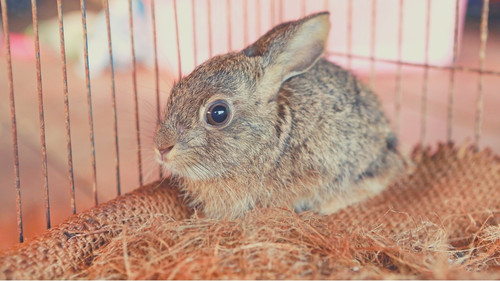
Good options for nonslip flooring in a rabbit’s enclosure include:
Washable Whelping Pads. (Kennel Mats) These large absorbent pads can go in your washer and dryer for cleaning.

Natural Fiber Rug. Jute, seagrass, or hemp rugs woven from natural fibers are pricier than polyester pads but are a great choice if you’re concerned about your rabbit chewing on synthetic fabrics. They’re also harder to clean but work great for potty-trained bunnies.

Cotton Towels. Towels aren’t my first choice because rabbits will scratch at them, move them around, and chew holes in them. But some bunny owners use them successfully.
If you use towels, make sure they are 100% cotton (preferably organic) because your rabbit will likely ingest some of the fibers.
Best Bedding for Outdoor Rabbits
If your rabbit lives outdoors in a hutch with a wooden floor, you should cover the cage floor in safe, easy-to-clean bedding. The purpose of the bedding is to absorb urine, reduce odor, and give the rabbit secure footing.
Do Outdoor Rabbits Need Bedding in the Winter?
Bedding can help insulate a hutch for rabbits that live outdoors in the winter. Rabbits have extremely warm coats and live outdoors in shockingly low temperatures if they have shelter and water. But providing a nesting box filled with bedding will help them conserve body heat.
Our top choices for bedding for outdoor rabbits include:
Aspen Shavings. Heat-treated hardwood shavings such as Small Pet Select’s Aspen Bedding are safe for bunnies. They are low-dust, free of synthetic chemicals, and moderately absorbent and insulating. Aspen shavings are relatively easy to clean and can be thrown on your compost pile.

E-Z Straw. This brand of straw has been cleaned, processed, and stored correctly to prevent mold or other pathogen growth. This makes it much safer to use than common barnyard straw. By using E-Z Straw, you’ll get the insulating benefit of the hollow tubes inside straw fibers, without the risk of traditional straw. You’ll still need to change it frequently, though!

Hemp Bedding. A little-known alternative, hemp or other grass bedding (such as elephant grass) is both safe and biodegradable.
Important: Never keep rabbits outdoors in cages with wire floors. Raccoons and dogs can kill rabbits through the wire. Since your outdoor rabbit cage must have a solid floor, you should use bedding in the hutch and change it regularly.
What Should Not Be Used as Rabbit Bedding?
Clay-based Cat Litter. Cat litter is designed to clump around urine or other moisture – which also means it will clump and cause blockages within your rabbit’s digestive tract.
Never use cat litter with rabbits; it can kill bunnies if they eat it.
Sawdust – Wood dust or sawdust will not only make a huge mess; it’s a respiratory irritant known to cause cancer!
Softwood Shavings (Cedar or Pine) – It may be tempting to use aromatic cedar or pine shavings in your rabbit hutch, but softwood shavings may carry risks. While some long-time rabbit breeders make a case for its safety, most experts including the House Rabbit Society warn against using pine or cedar shavings. They claim that the phenols that smell so good in softwood shavings cause toxic stress to a rabbit’s liver.
Hay – Hay is a healthy rabbit’s primary food source. If you use hay as bedding, your rabbit may try to eat hay that has been soiled with urine or droppings. This puts it at risk of coccidiosis.
Hay vs. Straw
What’s the difference between hay and straw? Hay is grass that has been cut and dried while it’s still green. Hay contains many beneficial nutrients.
Straw is the nutritionless stem of blanched oat or wheat. Rabbits aren’t usually tempted to eat it, but a little bit won’t hurt them. It’s good to get your straw from a trusted source, as conventional wheat and oat straw is often sprayed with glyphosate in the drying process.
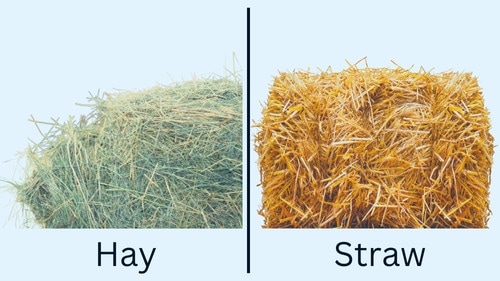
Frequently Asked Questions
Can I compost rabbit bedding?
Depending on the type of bedding you use, you can probably compost it right alongside your rabbit’s droppings. Paper bedding and aspen shavings can be composted. Wood shavings are a “brown” material in compost piles that complement “green” manure well.
Use caution when composting straw. Straw takes a long time to break down, and may contain wheat seeds or pathogens that you don’t want to introduce to your garden.
What Should I Do if My Rabbit is Peeing on its Bedding?
As we covered in this article, your bunny may not need bedding at all! Including bedding in its environment may cause your bunny to confuse its bed with its litter box. Try removing the bedding and see if this helps your potty training efforts.
Final Thoughts
The best bedding for your bunny pet depends on its housing environment and the climate where you live. If you need warm and insulating bedding for the winter months, then straw or aspen shavings are your top options. But if odor control is your priority, you’ll have the best results with a paper pulp option like CareFresh.


